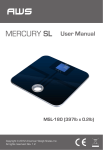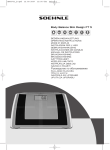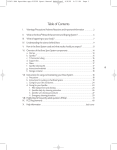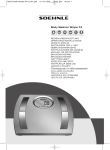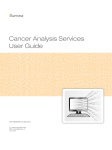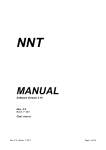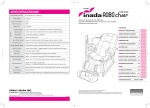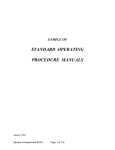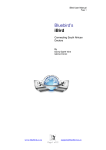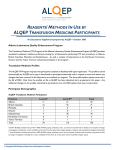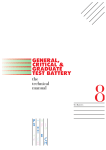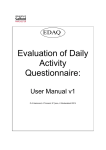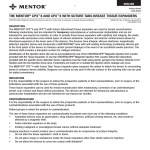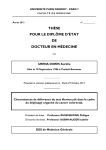Download User`s Manual
Transcript
USERS’ MANUAL VERSION 1.0 JULY 2012 Information in this document is subject to change without notice. Complying with all applicable copyright laws is the responsibility of the user. No part of this document may be reproduced or transmitted on any form or by any means, electronic or mechanical, for any purpose, without the express written permission of Memorial Sloan Kettering Cancer Center. Copyright © 2012 Memorial Sloan Kettering Cancer Center. Printing History: July 2012 Version 1.0 Trademarks: BREAST-Q is a registered trademark. Other products and company names mentioned herein may be the trademarks of their respective owners. While every precaution has been taken in the preparation of this Manual, the publisher assumes no responsibility for errors or omissions, or for damages resulting from the use of information contained herein. Installation Installation of Q-Score and accompanying manual is permitted from http://webcore.mskcc.org/breastq/ scoreBQ.html onto as many PC's as the number of licences permit as described in the Licence Details Certificate. Copying Copying or altering any parts of the BREAST-Q or Q-Score is not permitted. BREAST-Q User Manual Version 1.0 July 2012 Table of Contents 1. What is the BREAST-Q?.................................................................................................................... 3 1.1 BREAST-Q AUGMENTATION MODULE .............................................................................. 6 1.2 BREAST-Q REDUCTION/MASTOPEXY MODULE ............................................................. 7 1.3 BREAST-Q MASTECTOMY MODULE ................................................................................... 8 1.4 BREAST-Q RECONSTRUCTION MODULE .......................................................................... 9 2. Administration of the BREAST-Q .................................................................................................. 11 3. Scoring ............................................................................................................................................... 11 4. Interpretation .................................................................................................................................... 16 5. Technical Data ................................................................................................................................... 16 6. Translations ....................................................................................................................................... 17 7. Conditions of Use .............................................................................................................................. 19 8. Frequently Asked Questions ............................................................................................................ 20 9. Further Reading ................................................................................................................................ 24 www.BREAST-Q.org BREAST-Q User Manual Version 1.0 July 2012 1. What is the BREAST-Q? The BREAST-Q is a patient-reported outcome (PRO) instrument designed to evaluate outcomes among women undergoing different types of breast surgery. There are currently four BREAST-Q modules, each of which is comprised of multiple scales. 1) 2) 3) 4) Augmentation Reduction/Mastopexy Mastectomy Reconstruction A fifth module (the BREAST-Q: Breast Conserving Therapy (BCT) module) is in development for women undergoing lumpectomy with and without radiation for the treatment of breast cancer. All BREAST-Q modules are based on an underlying conceptual framework developed from extensive qualitative research with breast surgery patients, close examination of the research literature, and engagement of healthcare professionals working with breast surgery patients. Data collected from all three of these sources was used to formulate a breast surgery conceptual framework. The conceptual framework of the four BREAST-Q modules is comprised of two overarching themes (or domains). These are 1) Patient Satisfaction and 2) Health-related Quality of Life (QOL). Under each of these domains, there are six subthemes (i.e., QOL: Physical, Psychosocial and Sexual well-being patient; Patient Satisfaction: Satisfaction with breasts, Satisfaction with overall outcome and Satisfaction with Care) (see Figure 1). Body image is an important concept for breast surgery patients. This concept is measured by several of our BREAST-Q scales (see detailed descriptions of items for each scale starting on Page 7). All four modules have the same conceptual framework, with the exception of the Reconstruction module, which also includes the additional theme of ‘Patient Expectations.’ www.BREAST-Q.org BREAST-Q User Manual Version 1.0 July 2012 For each subtheme, one or more BREAST-Q scales were developed to examine specific aspects of patient satisfaction and QOL. For example, the Satisfaction with Care theme has four separate scales that measure Satisfaction with Information, Satisfaction with the Plastic Surgeon, with the Medical Team and with Office Staff. Across the various modules and patient treatment groups, these scales are psychometrically linked and can thus be used for comparison between different patient groups. Each BREAST-Q scale is composed of a series of items (or questions) that evaluate a unidimensional construct. The items that form each scale reflect a clinically relevant hierarchy. As an example, in the Reconstruction Module Satisfaction with Breasts scales, items span a range from “how satisfied are you with how you look in clothes?” to “How satisfied are you when you see yourself in the mirror unclothed?” Patient responses to each scale’s items are transformed through the Q-Score scoring software (described below) to provide a total scale score that ranges from 0 to 100. For all BREAST-Q scales, a higher score means greater satisfaction or better QOL (depending on the scale). It is important to note that patients do not need to complete all BREAST-Q scales in any given study or clinical encounter. Each scale is designed to function independently. Patients can thus be asked to complete some or all of a module’s BREAST-Q scales. A researcher or clinician may therefore select a subset of scales depending on purpose of the particular study or use. As an example, in a quality improvement program, the 4 scales evaluating Satisfaction with Care might be used (Satisfaction with Information, with Surgeon, with Medical Team, with Office Staff). Alternatively, the Satisfaction with Breast scale might be used alone in a study to evaluate a new breast surgery technique. There is no overall or total BREAST-Q score, only scores for each independent scale. Each module of the BREAST-Q has both pre-operative and post-operative versions. The post-operative version includes all the pre-operative items in addition to items that address unique postoperative issues (e.g. scars). The preoperative and postoperative scales are linked psychometrically to measure change. Women may complete the pre-operative questionnaire at any time prior to surgery (baseline assessment) and the post-operative questionnaire at any time point after surgery (follow-up data). The BREAST-Q may also be administered at a single time point as in a cross-sectional survey. Each researcher or clinician may decide the time points at which he/she would like to administer the scales. Of note, the BREAST-Q Reconstruction Module: Expectations scales differ in that they are designed for pre-operative administration only. For more information, please also see www.BREAST-Q.org. www.BREAST-Q.org BREAST-Q User Manual Version 1.0 July 2012 Table 1: Description of the BREAST-Q modules Total number of items Response scale(s) Mode of administration Time for completion 1/ Augmentation module: o Pre-operative, 25 items o Post-operative, 88 items 2/ Reduction/Mastopexy module: o Pre-operative, 39 items o Post-operative, 93 items 3/ Mastectomy module: o Pre-operative, 37 items o Post-operative, 63 items 4/ Reconstruction module: o Pre-operative, 42 items o Post-operative, 116 items Expectations for Reconstruction scales o Pre-operative, 42 items - 4-point Likert-like scales from 1 “Very dissatisfied” to 4 “Very satisfied” - 3-point Likert-like scales from 1 “disagree” to 3 “Definitely agree” - 5-point Likert-like scales from 1 “None of the time” to 5 “All of the time” (+/- Not applicable) - 4-point Likert-like scales from 1 “Definitely disagree” to 4 “Definitely agree” Self-administered, paper and pencil Electronic in development Varies based on the number of scales completed in each module. - Augmentation Module (all scales) 8 - 10 minutes - Reconstruction Module (all scales) 10 - 14 minutes - Reduction Module (all scales) 10 -12 - Mastectomy Module (all scales) 10-12 minutes - Recall period - In the past 2 weeks. An exception to this rule is the Sexual Well-being scale which has no recall period in the preoperative period. In the postoperative module, the recall period is “since the surgery”. (What about expectation?) www.BREAST-Q.org BREAST-Q User Manual Version 1.0 July 2012 1.1 BREAST-Q AUGMENTATION MODULE (APPENDIX 1 & 2) QUALITY OF LIFE DOMAINS 1. Psychosocial Well-being: This scale measures psychosocial well-being with items that ask about body image (e.g., accepting of body; attractive) and a woman’s confidence in social settings. Other items cover emotional health and self-esteem. 2. Sexual Well-being: This scale measures sexual well-being and body-image issues with items that ask about feelings of sexual attractiveness when clothed and unclothed and sexual confidence as it relates to one’s breasts, as well as how comfortable or at ease a woman feels during sexual activity. 3. Physical Well-being Chest and Upper Body: This scale captures negative physical sequelae of the chest and upper body. There are questions about symptoms of pain or tightness in the breast area as well as difficulty with mobility (e.g., lifting arms) and doing activities (e.g., running, lifting). SATISFACTION DOMAINS 1. Satisfaction with Breasts: This scale measures body image in terms of a woman’s satisfaction with her breasts. Items cover breast appearance (e.g., size, symmetry, softness, implant placement, cleavage), and satisfaction with breasts in relation to how a bra fits and how the breasts look when clothed or unclothed. There are also items specific to implants (e.g., rippling) and postoperative issues (e.g., scars). 2. Satisfaction with Outcome: This scale measures a woman’s overall appraisal of the outcome of her breast surgery. Items cover whether the woman’s expectations were met with respect to the aesthetic outcome and the impact surgery has had upon her life as well as satisfaction with the decision to have surgery (e.g. “I would do it again”). 3. Satisfaction with Care: a. Information: This scale measures satisfaction with information provided about breast augmentation surgery from the surgeon. Items cover complications and risks (e.g., implant leakage, loss of nipple sensation, capsular contracture, rippling), implications for future breast cancer screening and breast-feeding, healing and recovery time, how the surgery would be done, and breast appearance (e.g., breast size, scars). b. Surgeon: This scale measures satisfaction with the surgeon. Items ask about the surgeon’s manner (e.g., professional, reassuring, thorough, sensitive) and communication skills (e.g., easy to talk to). Items also cover the extent to which the patient was involved in the decision making and understood the process. c. Medical team: This scale measures satisfaction with members of the medical team (other than surgeon). Items ask whether the staff were professional, knowledgeable and friendly, as well as how comfortable the woman was made to feel and whether she felt she was treated in a respectful manner. d. Office Staff: This scale measures satisfaction with interactions with members of the office staff. Items ask whether staff were professional, knowledgeable and friendly, as well as how comfortable the woman was made to feel and whether she felt she was treated in a respectful manner. www.BREAST-Q.org BREAST-Q User Manual Version 1.0 July 2012 1.2 BREAST-Q REDUCTION/MASTOPEXY MODULE (APPENDIX 3 & 4) QUALITY OF LIFE DOMAINS 1. Psychosocial Well-being: This scale measures psychosocial well-being with items that ask about body image (e.g., accepting of body; attractive) and a woman’s confidence in social settings. Other items cover emotional health and self-esteem. 2. Sexual Well-being: This scale measures sexual well-being and body-image issues with items that ask about feelings of sexual attractiveness when clothed and unclothed and sexual confidence as it relates to one’s breasts, as well as how comfortable or at ease a woman feels during sexual activity. 3. Physical Well-being Chest and Upper Body: This scale captures physical problems caused by breast size including pain (e.g., breast, shoulder, back, neck), energy level, rashes and sleeping problems. There are also questions asking about activity limitations and balance. SATISFACTION DOMAINS 1. Satisfaction with Breasts: This scale measures body image in terms of a woman’s satisfaction with her breasts. Items cover breast appearance (e.g., size, symmetry, softness, cleavage), and satisfaction with breasts in relation to how a bra fits and how the breasts look when clothed or unclothed.. There are also postoperative only items (e.g., location and appearance of scars). 2. Satisfaction with Nipples: This scale measures satisfaction with the appearance of the nipple and areola complex. Items cover their location on the breast, symmetry, shape, and nipple sensation. 3. Satisfaction with Outcome: This scale measures a woman’s overall appraisal of the outcome of her breast surgery. Items cover whether the woman’s expectations were met with respect to the aesthetic outcome and the impact surgery has had upon her life as well as satisfaction with the decision to have surgery (e.g. “I would do it again”). 4. Satisfaction with Care: a. Information: This scale measures satisfaction with information provided about breast reduction surgery from the surgeon. Items cover complications and risks (e.g., loss of nipple sensation), implications for future breast cancer screening and breast-feeding, healing and recovery time, how the surgery would be done, and breast appearance (e.g., breast size, scars). b. Surgeon: This scale measures satisfaction with the surgeon. Items ask about the surgeon’s manner (e.g., professional, reassuring, thorough, sensitive) and communication skills (e.g., easy to talk to). Items also cover the extent to which the patient was involved in the decision making and understood the process. c. Medical Team: This scale measures satisfaction with members of the medical team (other than surgeon). Items ask whether the staff were professional, knowledgeable and friendly, as well as how comfortable the woman was made to feel and whether she felt she was treated in a respectful manner. d. Office Staff: This scale measures satisfaction with interactions with members of the office staff. Items ask whether staff were professional, knowledgeable and friendly, as well as how comfortable the woman was made to feel and whether she felt she was treated in a respectful manner. www.BREAST-Q.org BREAST-Q User Manual Version 1.0 July 2012 1.3 BREAST-Q MASTECTOMY MODULE (APPENDIX 7 & 8) QUALITY OF LIFE DOMAINS 1. Psychosocial Well-being: This scale measures psychosocial well-being with items that ask about body image (e.g., accepting of body; attractive) and a woman’s confidence in social settings. Other items cover emotional health and self-esteem. 2. Sexual Well-being: This scale measures sexual well-being and body-image issues with items that ask about feelings of sexual attractiveness when clothed and unclothed and sexual confidence as it relates to one’s breasts, as well as how comfortable or at ease a woman feels during sexual activity. 3. Physical Well-being: a. Chest and Upper Body: This scale captures negative physical sequelae of the chest and upper body. There are questions about shoulder, neck, back, arm, chest muscle and rib pain. There are also questions about breast area discomfort such as tightness, pulling, nagging, tenderness, aching and throbbing. There are also questions asking about activity limitations and balance. b. Abdomen and Trunk: This scale captures negative physical sequelae of the abdomen. Items cover abdominal discomfort, bloating and pain as well as difficulty doing certain activities due to abdominal weakness. There is a single item asking about abdomen appearance. SATISFACTION DOMAINS 1. Satisfaction with Breasts: This scale measures body image in terms of a woman’s satisfaction the breast area and asks questions regarding how comfortably bras fit, and how satisfied a woman is with her breast area both clothed and unclothed. 2. Satisfaction with Care: a. Surgeon: This scale measures satisfaction with the surgeon. Items ask about the surgeon’s manner (e.g., professional, reassuring, thorough, sensitive) and communication skills (e.g., easy to talk to). Items also cover the extent to which the patient was involved in the decision making and understood the process. b. Medical team: This scale measures satisfaction with members of the medical team (other than surgeon). Items ask whether the staff were professional, knowledgeable and friendly, as well as how comfortable the woman was made to feel and whether she felt she was treated in a respectful manner. c. Office Staff: This scale measures satisfaction with interactions with members of the office staff. Items ask whether staff were professional, knowledgeable and friendly, as well as how comfortable the woman was made to feel and whether she felt she was treated in a respectful manner. www.BREAST-Q.org BREAST-Q User Manual Version 1.0 July 2012 1.4 BREAST-Q RECONSTRUCTION MODULE (APPENDIX 5 & 6) QUALITY OF LIFE DOMAINS 1. Psychosocial Well-being: This scale measures psychosocial well-being with items that ask about body image (e.g., accepting of body; attractive) and a woman’s confidence in social settings. Other items cover emotional health and self-esteem. 2. Sexual Well-being: This scale measures sexual well-being and body-image issues with items that ask about feelings of sexual attractiveness when clothed and unclothed and sexual confidence as it relates to one’s breasts, as well as how comfortable or at ease a woman feels during sexual activity. 3. Physical Well-being: a. Chest and Upper Body: This scale measures physical problems such as pain (e.g., neck, back, shoulder, arm, rib) and problems in the breast area (e.g., tightness, pulling, tenderness, pain). Other items ask about activity limitations and sleep problems due to discomfort. b. Abdomen and Trunk: This scale measures negative physical sequelae of the abdomen following autologous tissue reconstruction (TRAM or DIEP flap). Items cover abdominal discomfort, bloating, bulging and pain as well as difficulty doing certain activities due to abdominal weakness. SATISFACTION DOMAINS 1. Satisfaction with Breasts: This scale measures body image in terms of a woman’s satisfaction with her breasts and asks questions regarding how comfortably bras fit, and how satisfied a woman is with her breast area both clothed and unclothed. Postoperative items ask about breast appearance (e.g., size, symmetry, softness) and clothing issues (e.g., how bras fit; being able to wear fitted clothes).There are also implant-specific items (e.g., amount of rippling that can be seen or felt 2. Satisfaction with Nipples: This scale measures satisfaction with the appearance of the reconstructed nipple and areola complex. Items cover shape, colour, projection and how natural the reconstructed nipple looks. 3. Satisfaction with Abdomen: This scale measures patient satisfaction with abdominal appearance following autologous tissue breast reconstruction (TRAM or DIEP flap). Items ask about overall appearance as well as position of navel (belly button) and scars. 4. Satisfaction with Outcome: This scale measures a woman’s overall appraisal of the outcome of her breast surgery. Items cover whether the woman’s expectations were met with respect to the aesthetic outcome and the impact surgery has had upon her life as well as satisfaction with the decision to have surgery (e.g. “I would do it again”). 5. Satisfaction with Care a. Information: This scale measures satisfaction with information provided about breast reconstruction surgery from the surgeon. Items cover types of breast reconstruction, complications and risks, healing and recovery time, how the breast(s) would look, implications for future breast cancer screening, how the surgery would be done, and breast appearance (e.g., breast size, scars). b. Surgeon: This scale measures satisfaction with the surgeon. Items ask about the surgeon’s manner (e.g., professional, reassuring, thorough, sensitive) and communication skills (e.g., easy to talk to). Items also cover the extent to which the patient was involved in the decision making www.BREAST-Q.org BREAST-Q User Manual Version 1.0 July 2012 and understood the process. c. Medical team: This scale measures satisfaction with members of the medical team (other than surgeon). Items ask whether the staff were professional, knowledgeable and friendly, as well as how comfortable the woman was made to feel and whether she felt she was treated in a respectful manner. d. Office Staff: This scale measures satisfaction with interactions with members of the office staff. Items ask whether staff were professional, knowledgeable and friendly, as well as how comfortable the woman was made to feel and whether she felt she was treated in a respectful manner. EXPECTATION DOMAINS These scales are designed to be administered pre-operatively and assess patient expectations for the process and outcome of surgery. The expectations scales compliment the satisfaction and quality-of-life domains of the post-operative reconstruction module. Multi-item and categorical scale structures are used. 1. Expectations for Support from Medical Staff: This scale measures how much time and emotional support the patient is expecting from the medical team and surgeon. 2. Expectations for Pain: This scale measures the magnitude of pain the patient is expecting to experience in the first week after reconstruction surgery. 3. Expectations for Recovery: This scale measures patient expectations regarding their recovery and return to normal activities in the first week after surgery. 4. Expectations for Coping: This scale measures how a patient is anticipating she will cope with the process of breast reconstruction during the first year after surgery. 5. Expectations for Breast Appearance and Outcome: This scale measures how a patient expects her breasts to look one year after surgery. 6. Expectations for Psychosocial Well-being: This scale measures how a patient expects to feel about herself one year after breast reconstruction. 7. Expectations for Sexual Well-being: This scale measures how a patient expects she will feel sexually one year after breast reconstruction. www.BREAST-Q.org BREAST-Q User Manual Version 1.0 July 2012 2. Administration of the BREAST-Q The BREAST-Q is a self-administered questionnaire. An entire BREAST-Q module can be completed in about 10-15 minutes. Each scale takes 1-4 minutes to complete. No specific training is required to complete any module of the BREAST-Q. Patients are given instructions in an introductory paragraph at the beginning of the questionnaire. The BREAST-Q is available in paper and pencil format; an electronic version is in development. 3. Scoring Instructions for Scoring BREAST-Q© data using QScore™ Q-Score, its accompanying manual and data entry templates are available to download from: http://webcore.mskcc.org/breastq/scoreBQ.html. To score BREAST-Q data using QScore: 1. Select the appropriate QScore Excel template corresponding to the version of the BREAST-Q module you need scored. For example, if you’ve been administering the BREAST-Q Postoperative Augmentation Module choose the Post-op Augmentation Template for data entry. Post-op BREAST-Q Augmentation Template opened in Excel 2. The second row of each template indicates the valid numerical values allowed for each scale. A value of ‘88’ should be entered if more than one answer choice was selected on the questionnaire, ‘66’ if the non-applicable (N/A) option was selected and ‘99’ for all missing information. Important: Avoid making any changes to the first three rows of the template. Any change to this area will cause errors when the data is imported to QScore. 3. When entering your data, make sure there are no empty cells within the data template. Missing data or cells of unused scales should have a value of ‘99’ entered. www.BREAST-Q.org BREAST-Q User Manual Version 1.0 July 2012 4. Once you have entered all your BREAST-Q data, press the ‘Export to QScore’ button in the upper left corner of the spread sheet. This process will save the data in a tab delimited text file, the required format for input to the QScore program. 5. Name your file (1) and click ‘Save’ (2) to save it to your hard drive. A dialog box will appear with the following message: ‘Data has been exported to [chosen directory]. This file will now close and you may now open the .txt file with the Scoring Utility. ’ 6. Start the QScore program. 7. Select the desired questionnaire version from the ‘Questionnaire’ drop down list. www.BREAST-Q.org BREAST-Q User Manual Version 1.0 8. Next, click ‘Browse Input File…’ and locate the text file you would like to import. 9. QScore will automatically score and display the results in an internal spread sheet. 10. Select ‘Export Scores’ at the bottom of the program window. www.BREAST-Q.org July 2012 BREAST-Q User Manual Version 1.0 July 2012 a. Name the file with the .xls extension (1) for example, ScoredBreastQ.xls b. select ‘All files (*.*)’ from the ‘Save as type:’ drop down list c. Click ‘Save’ to complete the export process 11. The ‘Output File:’ area in QScore now indicates the directory where the scored data has been saved. 12. Exit QScore. Opening QScore output in Excel: 1. Open the Excel spread sheet exported from QScore. A dialog box will appear with the following: ‘The file you are trying to open, ‘FILE NAME’, is in a different format than specified by the file extension. Verify that the file is not corrupted and is from a trusted source before opening the file. Do you want to open the file now? Select ‘yes’ Note: This message appears because the file is still being read as a text file www.BREAST-Q.org BREAST-Q User Manual Version 1.0 July 2012 2. The scored data is now opened and formatted for easy viewing in Excel. Save the spread sheet in an Excel format. 1. Saving the spread sheet in an Excel format will prevent the ‘…different format…’ message you received upon opening the file. To do this choose: a. The office button in Microsoft Excel 2007 ‘File’ in previous versions of Excel b. Select ‘Save As…’ c. And the Excel format you want from the ‘Save as type:’ drop down list. www.BREAST-Q.org BREAST-Q User Manual Version 1.0 July 2012 4. Interpretation All BREAST-Q scores range from 0-100. The scores are computed from the responses to the separate questions by adding them together and converting the score to a scale from 0 to 100 (similar to conversion into a percentage). A higher score means high satisfaction or better health-related quality of life. The clinical meaning of BREAST-Q scores and the smallest clinically significant differences are not yet defined (research is ongoing). However, the interpretation of the clinical significance of BREASTQ scores is facilitated by the recently available data from a study of 2000 patients at Memorial SloanKettering Cancer Center in New York (USA). The mean values of QL scores in the general population are indicated with an arrow on the printout to serve as a rough guide for the severity of the limitations / symptoms. A study of the subjective significance to the patients of changes in QL scores suggests that a mean change of 5 to 10 on the multi-item scales is perceived as ‘a little’ change, 10 to 20 as ‘a moderate’ change and greater than 20 as ‘very much’ change. Interpretative data on individual patients’ scores is not available, but longitudinal assessment at multiple time points should establish a personal norm for each individual patient. Then changes over time for an individual patient may be best judged in relation to what is ‘normal’ for that patient. It is also expected that as QL measurement becomes more common in clinical settings, intuitive familiarity will develop both through individual and collective experience, as has occurred for more established measures of disease activity and severity. For more information about the BREAST-Q we direct the reader to Section 8: Further Reading. 5. Technical Data A description of the development and validation of the BREAST-Q is available in Appendix 9 (From BREAST-Q © to Q-Score ©: Using Rasch Measurement to better capture breast surgery outcomes. Cano SJ, Pusic AL, Klassen A. Proceedings from the Joint International IMEKO TC1+ TC7+ TC13 Symposium, 90-102; 2011). For more information about the BREAST-Q, we direct the reader to Section 8: Further Reading. www.BREAST-Q.org BREAST-Q User Manual Version 1.0 July 2012 6. Translations The specific methodology used to produce the versions of the BREAST- Q Augmentation module is summarized in the table below. Linguistic validation process Language Forward Backward Adaptation Clinician's Translation Translation Review Not French applicable Not German applicable Not US Spanish applicable Not Swedish applicable Not Italian applicable Not UK English applicable Not Norwegian* applicable Not Polish* applicable Not Slovenian* applicable *denotes academic translations supervised by MAPI institute www.BREAST-Q.org Cognitive International Debriefing Harmonization BREAST-Q User Manual Version 1.0 July 2012 The specific methodology used to produce the versions of the BREAST- Q Reconstruction module is summarized in the table below. Language French Linguistic validation process Forward Backward Adaptation Translation Translation Not applicable Not applicable Not applicable Not applicable Not applicable Not applicable Not applicable Not applicable Not applicable Not applicable Not applicable Not applicable Not applicable Clinician's Cognitive International Review Debriefing Harmonization Not applicable Malay for Not Australia* applicable *denotes academic translations supervised by MAPI institute German US Spanish Dutch for Belgium* French for Belgium* Russian for Armenia* Icelandic* Dutch for Netherlands* Norwegian* Polish* Slovenian* Swedish* Mandarin Chinese for the US* Czech* There are no current translations for the Reduction/mastopexy module or the Mastectomy module. www.BREAST-Q.org BREAST-Q User Manual Version 1.0 July 2012 7. Conditions of Use The Memorial Sloan-Kettering Cancer and the University of British Columbia hold the copyright of the BREAST-Q and all its translations (past, on-going and future).To avoid any copyright infringement, a copyright notice shall be included on the original questionnaire and all its derivatives (including but not limited to translations) as follows: “Memorial Sloan-Kettering Cancer Center and The University of British Columbia © 2006, All rights reserved” Use of the BREAST-Q questionnaire requires completion of a User’s agreement with MAPI Research Trust. For permission to use the BREAST-Q, please contact: MAPI trust at [email protected] The use of the BREAST-Q™ and its modules in non-profit academic research and in clinical care is free of charge. The use of the BREAST-Q by “for-profit” organizations is subject to a fee per module per protocol. For questions regarding fees to be paid by ‘for-profit organizations’, please contact: Yashodhara Dash, M.B.B.S., Ph.D., M.B.A. Licensing Associate Office of Technology Transfer Memorial Sloan-Kettering Cancer Center 1275 York Avenue, New York NY 10065 [email protected] For questions regarding study design and optimal use of BREAST-Q scales, please see www.breastq.org or contact: Andrea Pusic MD MHS FACS FRCSC Memorial Sloan-Kettering Cancer Center 1275 York Avenue New York NY 10065 [email protected] www.BREAST-Q.org BREAST-Q User Manual Version 1.0 July 2012 8. Frequently Asked Questions Frequently Asked Questions: Ethics board (IRB approval) Do I need local ethics board (IRB) approval? If your intent is to collect BREAST-Q data for research purposes, a local ethics board must review your methods, patient recruitment, consent and privacy. If you are administering the BREAST-Q for clinical care, ethics board approval is generally not required. If in doubt, contact your local ethics board. Frequently Asked Questions: How to use the BREAST-Q Do I have to use all the scales? No, you do not have to use all scales. Patients can be asked to complete some or all of a module’s BREASTQ scales. It is not necessary for a patient to complete all of the scales within a module as there is no overall or total BREAST-Q score. A researcher or clinician may therefore select a subset of scales depending on the particular purpose of the study or use. Can I delete any items in the BREAST-Q? No, you cannot delete any items in a BREAST-Q scale. Any modification to the content of the BREAST-Q by deleting an item within a scale is not acceptable. There are three main reasons why deleting items is not allowed. The first is that deleting items from the BREAST-Q would nullify the psychometric properties of BREAST-Q scales. The second reason is that by deleting items, it would then not be possible to score the BREAST-Q and you would not be able to compare findings with those of other BREAST-Q studies. Finally, deleting items is prohibited under copyright laws. Can I change the wording of any item in the BREAST-Q? No, you cannot change any items in a BREAST-Q scale. Any modification to the content of the BREAST-Q by changing an item within a scale is not acceptable. There are three main reasons why changing items is not allowed. The first is that altering the wording of items in the BREAST-Q would nullify the psychometric properties of BREAST-Q scales. The second reason is by modifying items, it would then not be possible to score the BREAST-Q and you would not be able to compare findings with those of other BREAST-Q studies. Finally, changing the wording of items is prohibited under copyright laws. Can I add any items to the BREAST-Q? No, you cannot add any items to a BREAST-Q scale. Any modification to the content of the BREASTQ by adding items to a scale is not acceptable. There are three main reasons why adding items is not acceptable. The first is that adding items to the BREAST-Q would nullify the psychometric properties of BREAST-Q scales. The second is that by adding items, the scale can no longer be scored, making it impossible to compare findings with those of other BREAST-Q studies. Finally, altering the BREASTQ by adding items is prohibited under copyright laws. You may have however ask any additional questions that you wish as long as they are separate from the BREAST-Q scales. You can’t consider these questions to be part of the BREAST-Q. Which module do I use for oncoplastic procedures? For oncoplastic surgery procedures, the BREAST-Q Reduction/Mastopexy module and the BCT module are recommended depending on the exact nature of the procedure (i.e. for oncoplastic breast reduction, use Reduction module; for oncoplastic lumpectomy/glandular remodelling, use BCT module). For patients www.BREAST-Q.org BREAST-Q User Manual Version 1.0 July 2012 Which module do I use for fat grafting procedures? For patients undergoing fat grafting procedures, either the BREAST-Q Reconstruction or Augmentation modules may be used depending on the indications for the procedure (i.e. correction of defect following oncologic resection or cosmetic augmentation). Frequently Asked Questions: Translation of the BREAST-Q Can I translate the BREAST-Q into a new language? For translation of the BREAST-Q scales contact MAPI research trust. This organization will provide you with a current list of available languages of each module, and if a language is not available, the translation guidelines for linguistic validation and translation. [email protected] http://www.mapi-trust.org/services/questionnairelicensing/cataloguequestionnaires/111-breast-q Frequently Asked Questions: Administering the BREAST-Q Who helps patients to complete the questionnaire in clinic? The BREAST-Q scales were designed for self-completion. Are there specific time points when patients complete the scales? A researcher or clinician can decide the time points (pre and post-operatively) he or she would like to administer the scales. Each module of the BREAST-Q has a pre-operative and post-operative version. The post-operative version includes all the pre-operative items in addition to items that address unique postoperative issues (e.g. scars). Is there an electronic version I can use, or can I code a version for online administration with my patients? A validated electronic version of the BREAST-Q is in development. Please contact the authors for the availability. Can I automate my own scoring system for online data collection? A webserver system for real-time scoring is currently in development. Please contact the authors for the availability of this online system. Frequently Asked Questions: Patient questions about the BREAST-Q What should I do if the patient refuses to fill out the BREAST-Q? For research purposes, patients have the right to refuse to participate in a study. If the BREAST-Q is being used in clinical practice and the patient does not wish to complete the questionnaire, it is helpful to explain to the patient that BREAST-Q data is being collected to provide their healthcare provider with a complete understanding of their health as it relates to breast surgery. You can emphasize that the BREAST-Q is quick and simple to complete. What should I do if the patient does not want to answer to some or all of the questions? If non-completion is a result of the patient having trouble understanding a particular question, ask her to explain why she had difficulty responding and read the question verbatim for them. Do not rephrase the question. If the patient is still unable to answer the question, it is still possible to score a BREASTQ scale with missing data. www.BREAST-Q.org BREAST-Q User Manual Version 1.0 July 2012 If the patient does not like a particular question, or thinks it is unnecessary or inappropriate, emphasize that she can write her comment on the BREAST-Q and use all the space needed to express herself. What should I do if the patient asks for clarification of a question? While completing the BREAST-Q, some patients may ask for clarification of a particular question so that they can better understand and respond to it. You can help by rereading the question verbatim, but do not try to explain what the question means, rather suggest that the patient uses /her own interpretation of the question. All patients should answer the questions based on their own understanding of the items. What should I do if a patient asks why the BREAST-Q has to be filled out on more than one occasion (if administering the BREAST-Q prospectively)? Explain that patients must complete the same BREAST-Q at additional visits in order to see if their answers change with time. This will give a more complete picture of how a her health-related quality of life and satisfaction changes over time. Frequently Asked Questions: Scoring of the BREAST-Q How do I score the BREAST-Q? In order to achieve high quality data, the BREAST-Q data must be scored appropriately using QScore software. It is crucial that raw responses provided by patients be transformed into BREAST-Q scores using the Q-Score program. This program is provided free of charge on our Web site (www.BREASTQ.org). Using this program, researchers and clinicians are able to convert their raw questionnaire data into summary scores for each BREAST-Q scale. Scores will range from 0 to 100 (with a higher number indicating higher satisfaction or better quality of life). The transformation is essential, as it is through this process that the ordinal-level data are linearized by means of item calibrations. Using Q-Score, researchers may then compare their sample of patients with patients from different studies that have also used the BREAST-Q as all will be on a common metric. Is there one total score for the BREAST-Q? No, there is no summary score for all the BREAST-Q scales. Instead, each scale is independently scored. BREAST-Q scores are computed by using the Q-Score program, which is provided free of charge at www.breast-q.org. How do I enter missing data? Missing data should be entered as ‘99’ in the appropriate scoring template. If a response is left blank in the template, the scoring software will give you an error message. What do I do if a patient has selected more than one response to a question? If the patient has selected more than one response to a question the patient has not responded properly to the question and the response should be scored as ‘88’ in the appropriate scoring template to indicate the patient has responded with a double answer. What do I do if a patient has selected ‘not applicable’ or written ‘not applicable’ on the questionnaire? If the patient has indicated their response to a question is ‘not applicable’ enter ‘66’ in the appropriate scoring template. www.BREAST-Q.org BREAST-Q User Manual Version 1.0 www.BREAST-Q.org July 2012 BREAST-Q User Manual Version 1.0 July 2012 9. Further Reading BREAST-Q development and validation publications Pusic AL, Chen CM, Cano S, Klassen A, McCarthy C, Collins ED, Cordeiro PG. Measuring quality of life in cosmetic and reconstructive breast surgery: a systematic review of patient-reported outcomes instruments. Plast Reconstr Surg. 2007 Sep 15; 120(4):823-37 Pusic AL, Reavey PL, Klassen AF, Scott A, McCarthy C, Cano S. Measuring patient outcomes after breast augmentation: Introducing the BREAST-Q: Augmentation Module. Clin Plast Surg. 2009 Jan;36(1):23-32. Klassen A, Pusic AL, Scott A, Klok J, Cano S. Satisfaction and quality of life in women who undergo breast surgery: A qualitative study. BMC Women's Health. 2009 May 1;9:11. Pusic AL, Klassen A, Scott A, Klok J, Cordeiro PG, Cano SJ. Development of a New Patient Reported Outcome Measure for Breast Surgery: The BREAST-Q©. Plast Reconstr Surg. 2009 Aug;124(2):34553. Chen CM, Cano SJ, Klassen AF, King T, McCarthy C, Cordeiro PG, Morrow M, Pusic AL. Measuring quality of life in oncologic breast surgery: a systematic review of patient-reported outcome measures. Breast J. 2010 Nov-Dec;16(6):587-97. Cano SJ, Klassen AF, Pusic AL. From BREAST-Q© to Q-Score©: Using Rasch Measurement to Better Capture Breast Surgery Outcomes. Joint International IMEDO TCI + TC7 +TC13 Symposium. 2011 Aug 31-Sept 2: Jena, Germany. urn:nbn:de:gbv:ilm1-2011imeko:2. Cano SJ, Klassen AF, Scott AM, Cordeiro PG, Pusic AL. The BREAST-Q: Further Validation in Independent Clinical Samples. Plast Reconstr Surg. 2012 Feb;129(2):293-302. Pusic AL, Klassen AF, Snell L, Cano SJ, McCarthy C, Scott A, Cemal Y, Rubin LR, Corderio PG. Measuring and managing patient expectations for breast reconstruction: impact on quality of life and patient satisfaction. Expert Rev Pharmacoecon Outcomes Res. 2012 Apr;12(2):149-58. Publications using the BREAST-Q Hu ES, Pusic AL, Waljee JF, Kuhn L, Hawley ST, Wilkins E, Alderman AK. Patient-reported aesthetic satisfaction with breast reconstruction during the long-term survivorship period. Plast Reconstr Surg. 2009 Jul; 124 (1): 1-8. Macadam SA, Ho AL, Cook EK Jr, Lennox PA, Pusic AL. Patient satisfaction and health-related quality of life following breast reconstruction: A comparison of patient-reported outcomes amongst saline and silicone implant recipients. Plast Reconstr Surg 2010 Mar;125(3):761-71. McCarthy C, Klassen AK, Cano SJ, Scott A, VanLaeken N , Lennox PA, Alderman AK, Mehrara BJ, Disa JJ, Cordeiro PG, Pusic AL. Patient Satisfaction with Postmastectomy Breast Reconstruction: A Comparison of Saline and Silicone Implants. Cancer,2010Dec;116(24):5584-91. www.BREAST-Q.org BREAST-Q User Manual Version 1.0 July 2012 Salgarello M, Rochira D, Barone-Adesi L, Farallo E. Immediate Breast Reconstruction After Skin- or Nipple-Sparing Mastectomy for Previously Augmented Patients: A Personal Technique. Aesthetic Plast Surg. 2011 Sep 10. Goyal A, Wu JM, Chandran VP, Reed MW. Outcome after autologous dermal sling-assisted immediate breast reconstruction. Br J Surg. 2011 Sep;98(9):1267-72. Salgarello M, Visconti G, Barone-Adesi L. Fat Grafting and Breast Reconstruction with Implant: Another Option for the Irradiated Breast Cancer Patients. Plast Reconstr Surg. 2011 Oct 18. Zhong T, McCarthy C, Min S, Zhang J, Beber B, Pusic AL, Hofer SO. Patient satisfaction and healthrelated quality of life after autologous tissue breast reconstruction: A prospective analysis of early postoperative outcomes.Cancer. 2011 Oct 24. Jeevan R, Cromwell D, Browne J, van der Meulen J, Caddy CM, Pereira J, Sheppard C, et al. Fourth Annual Report of the National Mastectomy and Breast Reconstruction Audit 2011. Leeds: The NHS Information Centre, 2011. http://www.ic.nhs.uk/mbr McCarthy CM, Cano SJ, Klassen AF, Scott AM, VanLaeken NY, Lennox PA, Cordeiro PG, Pusic AL. The Magnitude of Effect of Cosmetic Breast Augmentation on Patient Satisfaction and Health-Related Quality of Life. Plast Reconstr Surg. Accepted Suggested further reading about patient-reported outcomes in plastic surgery Cano SJ, Klassen A, Pusic AL. The science behind quality-of-life measurement: a primer for plastic surgeons. Plast Reconstr Surg 2009 Mar;123(3):98e-106e. Rubin L, Klassen AF, Cano SJ, Hurley K, Pusic AL. Motivations for breast surgery: a qualitative comparison study of breast reconstruction, augmentation, and reduction patients. The Breast Journal. 2009 Nov-Dec;15(6):666-7. Epub 2009 Sep 7. Spector D, Mayer D, Knafl K, Pusic A. Not What I Expected: Informational Needs of Women Undergoing Breast Surgery. Plastic Surgical Nursing. April-June 2010 Vol 30, 2, 70-74. Winters, Z.E., Benson, J.R., Pusic, A.L. A Systematic Review of the Clinical Evidence to Guide Treatment Recommendations in Breast Reconstruction Based on Patient-Reported Outcome Measures and Health-Related Quality of Life. Ann Surg. 2010 Aug 19. Cano, S., Klassen, A.F., Scott, A., Thoma, A., Feeny, D., Pusic, A. Health outcome and economic measurement in breast cancer surgery: challenges and opportunities. Expert Rev Pharmacoecon Outcomes Res. 2010 Oct;10(5): 583-94. Morrow M, Pusic AL. Time for a new era in outcomes reporting for breast reconstruction. J Natl Cancer Inst. 2011 Jan 5;103(1):5-7. Epub 2010 Dec 3. Pusic AL, Lemaine V, Klassen AF, Scott AM, Cano SJ. Patient-reported outcome measures in plastic surgery; use and interpretation in evidence-based medicine. Plast Reconstr Surg. 2011 Mar;127(3):1361-7. www.BREAST-Q.org






























